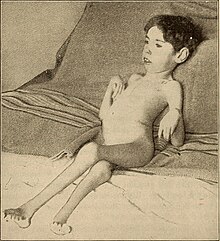Contracture
| Contracture | |
|---|---|
 | |
| Specialty | Orthopedics |

In pathology, a contracture is a shortening of muscles, tendons, skin, and nearby soft tissues that causes the joints to shorten and become very stiff, preventing normal movement.[1][2] A contracture is usually permanent, but less commonly can be temporary (such as in McArdle disease),[3] or resolve over time but reoccur later in life (such as in Bethlem myopathy 1).[4]
It is usually in response to prolonged hypertonic spasticity in a concentrated muscle area, such as is seen in the tightest muscles of people with conditions like spastic cerebral palsy, but can also be due to the congenital abnormal development of muscles and connective tissue in the womb.
Contractures develop usually when normally elastic tissues such as muscles or tendons are replaced by inelastic tissues (fibrosis). This results in the shortening and hardening of these tissues, ultimately causing rigidity, joint deformities and a total loss of movement around the joint.
Most of the physical therapy, occupational therapy and other exercise regimens targeted towards people with spasticity focuses on trying to prevent contractures from happening in the first place. However, research on sustained traction of connective tissue in approaches such as adaptive yoga has demonstrated that contracture can be reduced,[5] at the same time that tendency toward spasticity is addressed.
Causes of muscle contracture
[edit]Contractures can have a variety of causes other than spasticity. In regards to muscle, these include (but not limited to):
- Ischemia (restriction of blood flow) leading to the death of muscle tissue, as in Volkmann's contracture.
- Muscle injury leading to adhesions and fibrosis (internal scarring). Fibrosis occurs within a muscle or organ, whereas adhesions bind two separate tissues or organs together.
- Immobilization,
- A muscle imbalance between an agonist and antagonist muscle,
- In response to impending muscle damage associated with ATP (energy) deficiency,
- Congenital abnormalities of muscle development.
Skin contracture
[edit]Wound contraction, where the edges of the skin are pulled together to close the wound, is a normal part of wound healing. However, large wounds and abnormal wound healing cause skin contractures by excessively tightening the skin and limiting movement.[6][7][8] A skin contracture due to a burn is known as a burn scar contracture.
Large areas of missing skin (such as large burns, grazes, and gouges) drastically reduce the area of skin causing it to become tight when pulled together during wound healing.[6][7] Scars initially lack elasticity with synthesis of elastic tissue fibres (elastogenesis) being a function of duration and site of the scar.[9] Deep wounds and abnormal wound healing causes abnormal scarring such as hypertrophic scars.[8] Studies on hypertrophic scars have shown a lack of improvement to both elasticity and stiffness suggesting a prolonged healing phase without amelioration seen in a normal wound-healing curve.[10][11]
Surgery can help alleviate skin contractures in the form of skin grafts and removal of hypertrophic scars.[8][6] For hypertrophic scars, timing is important when considering surgery, as over time scars will mature and may show decreased contractures along with flattening, softening, and repigmentation without surgical intervention.[8]
See also
[edit]- Arthrogryposis
- Burn scar contracture
- Capsular contracture
- Clubfoot
- Dupuytren's contracture
- Freeman–Sheldon syndrome
- Marden–Walker syndrome
- Muscle contracture
- Volkmann's contracture
References
[edit]- ^ Clavet H, Hébert PC, Fergusson D, Doucette S, Trudel G (March 2008). "Joint contracture following prolonged stay in the intensive care unit". CMAJ. 178 (6): 691–7. doi:10.1503/cmaj.071056. PMC 2263098. PMID 18332384.
- ^ "Definition of contracture". www.cancer.gov. 2011-02-02. Retrieved 2023-05-06.
- ^ Lucia, Alejandro; Martinuzzi, Andrea; Nogales-Gadea, Gisela; Quinlivan, Ros; Reason, Stacey; International Association for Muscle Glycogen Storage Disease study group (December 2021). "Clinical practice guidelines for glycogen storage disease V & VII (McArdle disease and Tarui disease) from an international study group". Neuromuscular Disorders. 31 (12): 1296–1310. doi:10.1016/j.nmd.2021.10.006. ISSN 1873-2364. PMID 34848128. S2CID 240123241.
- ^ Bönnemann, Carsten G. (2011-06-21). "The collagen VI-related myopathies: muscle meets its matrix". Nature Reviews. Neurology. 7 (7): 379–390. doi:10.1038/nrneurol.2011.81. ISSN 1759-4758. PMC 5210181. PMID 21691338.
- ^ Nambi, Gopal S & Amisha Atul Kumar Shah (2013). "Additional effect of iyengar yoga and EMG biofeedback on pain and functional disability in chronic unilateral knee osteoarthritis". International Journal of Yoga. 6 (2): 123–127. doi:10.4103/0973-6131.113413. PMC 3734638. PMID 23930031.
- ^ a b c "Contractures". stanfordhealthcare.org. Retrieved 2023-05-07.
- ^ a b Kwan, Peter O.; Tredget, Edward E. (2017-05-01). "Biological Principles of Scar and Contracture". Hand Clinics. Burns. 33 (2): 277–292. doi:10.1016/j.hcl.2016.12.004. ISSN 0749-0712. PMID 28363295.
- ^ a b c d Gauglitz, Gerd G; Korting, Hans C; Pavicic, Tatiana; Ruzicka, Thomas; Jeschke, Marc G (2011). "Hypertrophic Scarring and Keloids: Pathomechanisms and Current and Emerging Treatment Strategies". Molecular Medicine. 17 (1–2): 113–125. doi:10.2119/molmed.2009.00153. ISSN 1076-1551. PMC 3022978. PMID 20927486.
- ^ Roten, S. V.; Bhat, S.; Bhawan, J. (February 1996). "Elastic fibers in scar tissue". Journal of Cutaneous Pathology. 23 (1): 37–42. doi:10.1111/j.1600-0560.1996.tb00775.x. ISSN 0303-6987. PMID 8720985. S2CID 37823718.
- ^ Rapp, Scott J.; Rumberg, Aaron; Visscher, Marty; Billmire, David A.; Schwentker, Ann S.; Pan, Brian S. (February 2015). "Establishing a Reproducible Hypertrophic Scar following Thermal Injury: A Porcine Model". Plastic and Reconstructive Surgery – Global Open. 3 (2): e309. doi:10.1097/GOX.0000000000000277. PMC 4350315. PMID 25750848.
- ^ Linares, Hugo A.; Larson, Duane L. (1976-10-01). "Elastic tissue and hypertrophic scars". Burns. 3 (1): 4–7. doi:10.1016/0305-4179(76)90003-6. ISSN 0305-4179. S2CID 72414472.
